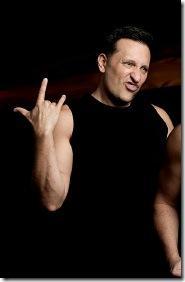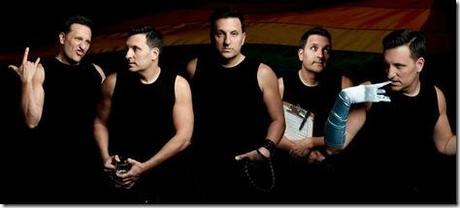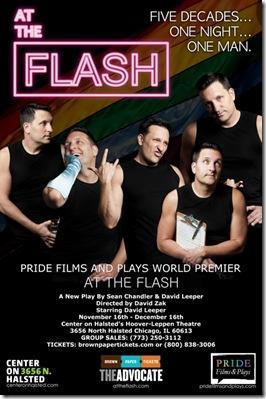
At the Flash
Written by Sean Chandler and David Leeper
Directed by David Zak
Center on Halsted, 3656 N. Halsted (map)
thru Dec 16 | tickets: $21-$25 | more info
Check for half-price tickets
Gay history in America through the eyes of five guys and one bar

Pride Films and Plays presents
At the Flash
Review by John Olson
The modern and expansive Center on Halsted, in which this play is performed at its Hoover-Leppen Theatre, opened in 2004 as a community center for Chicago’s LGBTQ people. As this play reminds us, though, through most of the 20th Century, gay bars were the unofficial centers of the community, and At the Flash gives us an 80-minute overview of LGBT history in America through the eyes of five characters and one gay bar. Co-author David Leeper plays all five – a closeted married gay man in 1965, a black drag queen in the 1970s, an HIV-positive club kid in the 1980s, a Lesbian political activist in the 1990s and a successful businessman with a same-sex partner and a child in the present day. LGBT history is told in personal terms through these five characters, giving us the facts of the times but framing the realities and challenges of life for each as individuals.

From the opening scene, action flashes back to 1965, when The Flash was a dive, and closeted gay men would sneak in on the sly. Richard, a married man with children, has been fighting his orientation by fathering kids, so he says. But with each newborn, he’s quickly drawn to his sexual attraction to men and this scene depicts the night in which he first furtively walks into The Flash. We’re introduced to the other three characters in chronological order. We next meet Miss Sparkle, the black drag queen showing the ropes to a new performer at the club sometime in the ‘70s, then Derrick – a young & effeminate club kid is on the rebound from a broken relationship using drugs, drink and dancing to ease his pain. In the 1990s, Mona is flexing the emerging political muscle of the LGBT community.
From there, action rotates among the five in random order as their circumstances are gradually revealed. Richard meets and shares a slow dance with another man at the club only to have the evening end prematurely and badly when The Flash is visited by the cops in a pre-Stonewall style raid. Miss Sparkle reveals her personal history to the budding performer, Derrick is shown to have HIV, and Mona is unable to be in the hospital room when her partner dies because they are not legally wed spouses. Rod is still working with his parents for acceptance, even as he is achieving success as a businessman, husband and father.
Under David Zak’s direction, Leeper moves quickly and smoothly between the characters. He’s most effective as the more flamboyant characters of the club kid and the drag queen, and he’s also quite convincing as the closeted, conflicted Richard of the ‘60s. His Mona and Rod are less interesting and need some more detail or rough edges in the writing to give him something to work with as an actor. Both characters are exceedingly well-intentioned, and writers Leeper and Sean Chandler (who have been legally married since 2008) back off from giving them faults or idiosyncracies that would make them more fun to play and to watch.
At the Flash succeeds most as an accurate and heartfelt piece of gay history. It’s one which can be shared with audiences of all types, as it has little actual sexual content or references that might be uncomfortable for those with more conservative sensibilities. Though its information may be familiar to those who have been around the community for a while, At the Flash could be a great primer on gay history for younger members of the community or anyone else seeking a better understanding of America’s journey toward providing space for LGBTs to live open lives with the same opportunities for safety, security and happiness as anyone else in the society.
Rating: ★★★
At the Flash continues through December 16th at Center on Halsted’s Hoover-Leppen Theatre, 3656 N. Halsted (map), with performances Fridays and Saturdays at 7:30 and Sundays at 3:30. Additional performances on Wednesdays/Thursdays November 28, 29, December 5, 6, 12, and 13. No performance Friday, December 7. Tickets are $21-$25, and are available online through BrownPaperTickets.com (check for half-price tickets at Goldstar.com). More information at pridefilmsandplays.com. (Running time: 80 minutes, no intermission)
artists
cast
David Leeper (Rod, Richard, Miss Sparkle, Derrick, Mona)
behind the scenes
David Zak (director), Jay Españo (assistant director/movement coach), Alexander St. John (sound designer), Garvin Jellison (lighting designer), Jessica Forella (stage manager).

